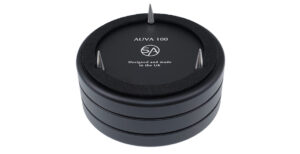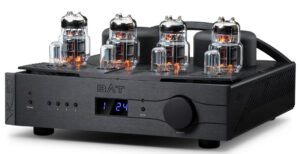
The Usher Be20 DMD, the top of its Dancer range, cost £15,750 per pair. For a loudspeaker this powerfully built in today’s market, that’s chicken feed. This is a solidly built piece of equipment (123kg in its spiked feet) that takes up a lot of listening room space, but uses absolute state of the art driver technology. Chris Martens reviewed the Usher Be20 for our sister title The Absolute Sound in 2008, but now the model has been revised to feature an inverted dome diamond-metal-diamond (DMD) tweeter, said to be lighter and stiffer than diamond alone. That’s the main change over its predecessor, but that isn’t to say the previous model wasn’t similarly highly specified. The ‘Be’ prefix in the name denotes Beryllium – the material used in Usher’s custom-designed 125mm inverted dome midrange driver. The DMD tweeter and Be midrange driver are joined by a pair of 275mm, Eton-made, Kevlar woofers, all packaged in a four and a half foot (140cm) tall, back-swept speaker that is bi-wired and rear-ported. There’s even a little panel at the front of the speaker (just above the plinth) into which you can have your name engraved.
The statistics that back this speaker up are pretty impressive too. It’s capable of delivering bass down to 22Hz and goes up to 40kHz (±3dB). It’s a tolerably sensitive 90dB and an unfussy four-ohm load, and is intended to partner any amp between 60-200W power output. Of course, specs like these imply the need for a large room, not least because these speakers are almost a metre deep, more than a third of a metre wide and need to be at least a metre from the rear and side walls, and more than two metres apart. To use these speakers optimally, listeners will need a lot of real estate.
Typically, this kind of loudspeaker will require an age to run in. Diamond tweeters and Kevlar are usually in their happy place after a few days of music replay, but the Beryllium midrange unit is likely to take a while to bed in. But there aren’t that many pairs of Be20 DMD speakers in the country, and our pair have been on the demonstration circuit for some time (Usher recommends about 180 hours to peak performance), so they arrived fully ready for action.
I like, use, and recommend small loudspeakers, primarily because I believe they are under-appreciated in the high-end community and that city-dwelling audiophiles cannot afford to have large, dedicated listening spaces. However, it’s hard to remain true to the small speaker cause when you are faced with the kind of deep, powerful, visceral, chewy, full-bodied bass that only a large loudspeaker cabinet filled with big drivers can deliver. It’s not just bass weight these loudspeakers deliver; it’s bass sure-footedness. Yes, there is an almost irresistible urge to pump some Leftfield, James Blake, or Dub Syndicate through the Ushers and see what it does to the squishier organs in your body. And when you inevitably do this, you get some very deep, visceral low tones. But, it’s the absolute confidence this speaker has at reinforcing its sound that wins you over, because gives it space and air and openness further up the registers.

That low underpinning gives the Be20 DMD first-rate soundstaging. OK, so it’s not going to be on a par with the Quads elsewhere in this issue, but in terms of instruments sitting in a wide, yet deep soundstage, the Be20 DMD does an outstanding job. The only experience of the pre DMD-version I have is my colleague’s 2008 review, but I’d wager the diamond tweeter gives it an even better sense of control over the edges of the soundstage, which had a tendency to collapse slightly in the previous version. The speaker is still not a big fan of wide panning, and it doesn’t give too much of an impression of image height, even though it does reveal insight into the recording space. The soundstage is layered and expansive and has a sense of a third dimension (it passes the Chesky LEDR test, for example), but it just doesn’t show image height off as well as it does image width and depth.
It is uncommonly detailed and dynamic, though. The DMD tweeter gives the speaker a cleaner treble than Chris Martens noted in 2008, but not so clean as to be too bright. This is highlighted by the classic Super Session by Bloomfield, Kooper and Stills [Sony Music CD]. This legendary blues cut from the 1960s can go horribly wrong and sound thin and awful; but here it just sounded like a trio of stoners, who just happened to be musical geniuses noodling around. This comes down to its uncanny and extremely natural dynamic range, just letting the speakers get out of the way of the recording. It’s hard for this album to play well, and the Usher is all the better for being able to ace this.
So, precisely what do you lose by going after a big loudspeaker, which doesn’t cost two, three, or even five times that of the Usher? Often, it comes down to ‘onslaught’. Compare the Be20s with the big names with the big price tags, and you get a loudspeaker that can move a lot of air with a lot of force. The Usher is no whispering giant, but if you want to play the Telarc 1812 Overture at the ‘duck and cover’ levels when the cannons start, you need to cast your net wider. That said, generally, you’ll need an amplifier the size of a small block V8 (and the cost of an engine factory) to drive this kind of speaker well. Conversely, there are also loudspeakers at higher price brackets that don’t have that eyeball-pushing drive either, and some of them become harder to justify. A really good detail hound loudspeaker will make a sound that justifies its place in the high-end star system even if it doesn’t go loud, and there are loudspeakers that do effortless dynamics, or have exceptional grace, tonal colour, an ability to keep precise control over time signature, and several other key concepts that make them worthy challengers to the Usher’s thrown-down gauntlet.
OK, so away from the heady air breathed in audiophile circles, nearly £16,000 is a heck of a lot of money to pay for a pair of loudspeakers, but in the Usher Be20 DMD, you do get a heck of a lot of loudspeaker for the money. This speaker gives away few concessions when put against far more expensive loudspeaker designs. If you give them a big room in which to breathe, these big Ushers don’t just offer a taste of the high-end, they give you the kind of high-end performance you’ll struggle to better this side of £30,000, maybe even £40,000, and that’s an exciting prospect.
Technical Specifications
- Type: 3-way, four-driver, rear-ported floorstanding loudspeaker.
- Driver complement: One 32mm Diamond DMD dome tweeter, 125mm Beryllium 0541A midrange dome, 2x ETON 11-584 275mm Kevlar woofers.
- Inputs: Two pairs of 4mm gold-plated connectors
- Crossover frequencies: 385Hz, 3.5kHz
- Frequency response: 23Hz – 40kHz (-3dB)
- Impedance: 4 Ohms
- Sensitivity: 90dB/W/m
- Dimensions (HxWxD): 1400 x 365 x 895mm
- Weight: 123kg/each (including base)
- Finishes: walnut, cherry, maple
- Price: £15,750/pair
Manufacturer: Usher Audio Technology
URL: www.usheraudio.com
UK Distributor: DECENT Audio
Tel: +44(0) 5602 054669
Tags: FEATURED
By Alan Sircom
More articles from this authorRead Next From Review
See all
Stack Audio AUVA 100
- May 16, 2024

Xavian Virtuosa Anniversario
- May 16, 2024

REL Classic 98
- May 07, 2024

Balanced Audio Technology VK80i
- May 07, 2024










